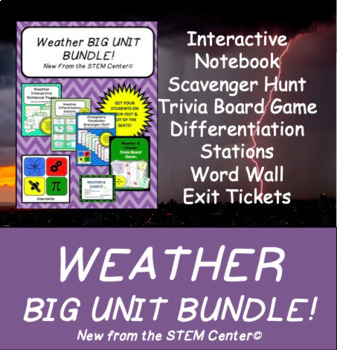Weather: BIG UNIT BUNDLE
- Zip
Products in this Bundle (20)
showing 1-5 of 20 products
Description
Weather: BIG UNIT BUNDLE has a lot to offer! You will save a lot of time on prep work, and money with this bundle.
This product priced with teachers in mind! - YOU SAVE MONEY! - Maximum 30%
With New Bundle format, you may take a look at each resource in the bundle.
- Distance Learning MP4/Power Point Video
*Weather & Atmosphere
- Min-Escape Room
- Notes
- Web Quest
- Power Point
- Scoot
- Battle Ship Game
- Interactive Notebook
- Scavenger Hunt
- Exit Tickets
- Word Wall
- Atmosphere Bingo!
- Beat the Clock Game
- Trivia Board Game
- Tic-Tac-Trivia
- Differentiation Stations
- Article with Q/A
- Maze Game
*This PDF is not editable.
YOU WILL WANT TO CHECK THIS OUT!:
Connect with the STEM Center©
Be sure to follow my TpT store by clicking on the Green ‘Follow Me’ Star next to the STEM Center © icon to receive notifications of new products and upcoming sales.
BLOG for more great activities and freebies.
Follow me on Twitter
Great info and freebies on Facebook
See all our products on Pinterest
Join Us on OurPodcast
Copyright © The STEM Center. All rights reserved by author. This product is to be used by the original downloader only. Copying for more than one teacher, classroom, department, school, or school system is prohibited. This product may not be distributed or displayed digitally for public view. Failure to comply is a copyright infringement and a violation of the Digital Millennium Copyright Act (DMCA). Clipart and elements found in this PDF are copyrighted and cannot be extracted and used outside of this file without permission or license. Intended for classroom and personal use ONLY.





